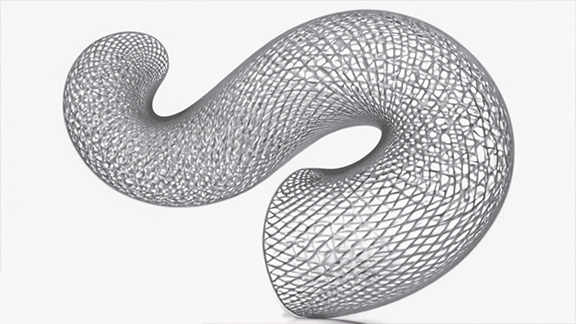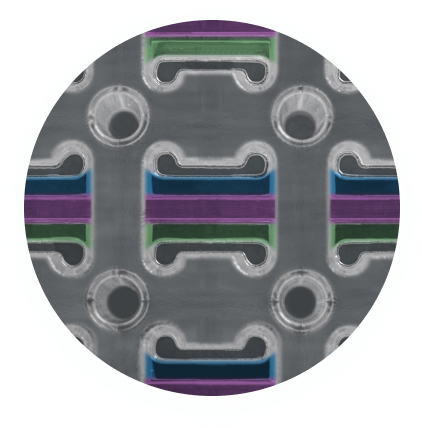Understanding Flow Diverter Innovative Coatings
Treating complex brain aneurysms often requires advanced devices like neurovascular flow diverters. These implants redirect blood flow to promote healing however, their success depends heavily on surface performance. Biocompatible coatings like Camouflage™ are emerging as key enhancements, helping to reduce the risk of thrombus formation, encouraging natural vessel repair and closure of the aneurysm neck.
Flow diverters offer a minimally invasive method to treat these aneurysms, especially those that are difficult to manage with traditional surgical techniques. However, their performance and safety heavily rely on the type of coating used on the device, as it must function within a highly sensitive environment—the human bloodstream.
At Smart Reactors, we have developed an innovative hemocompatible coating called Camouflage™, specifically designed for flow diverters. Camouflage™ addresses the need for improved device biocompatibility by promoting natural healing while minimizing the risk of complications such as thrombosis.
In this blog, we will explore the critical role that flow diverters play in treating complex aneurysms, the importance of coatings in enhancing their effectiveness, and why our Camouflage™ coating stands out as a superior choice for medical device manufacturers, clinicians, and patients alike.
Understanding Neurovascular Flow Diverters
Neurovascular flow diverters are braided stents that are primarily used to treat large or complex aneurysms in the brain. Unlike traditional treatments such as surgical clipping or endovascular coiling, which aim to isolate the aneurysm, flow diverters function by redirecting blood flow away from the aneurysm itself. This redirection lowers the pressure on the aneurysm wall, and allows the aneurysm neck to close over time. Fig 1 is an example of a braided flow diverter.

Flow Diverters Mechanism of Action
Flow diverters are deployed via a minimally invasive procedure, typically through a catheter inserted into Flow diverters are deployed via a minimally invasive procedure, typically through a catheter inserted into the femoral artery, which is then guided to the brain. Once in place, the device forms a mesh-like scaffold across the neck of the aneurysm, diverting blood away from the weakened vessel wall. The reduction in blood flow encourages the body’s natural repair processes allowing the aneurysm to clot and the vessel wall to stabilize.
Applications of Flow Diverters

Flow diverters are particularly useful in treating:
Complexly located aneurysms: Some aneurysms are located in parts of the brain that are difficult to access surgically, making flow diverters a minimally invasive and safer alternative.
Large or giant aneurysms: Aneurysms larger than 10 mm in diameter are considered large or giant and are often difficult to treat with conventional methods.
Wide-neck aneurysms: These aneurysms have a base that is too wide for effective coiling, making flow diversion a safer and more effective option.
Fusiform aneurysms: Aneurysms that affect a large portion of the vessel wall rather than forming a distinct sac can become more challenging to treat with traditional methods.
Complex aneurysms pose unique challenges in neurovascular treatment. These aneurysms can be defined by their size, shape, or location in the brain, making them harder to manage with standard treatment methods. For example, aneurysms that are particularly large or have wide necks cannot be safely coiled, as the coils may not stay in place or may not fully isolate the aneurysm from blood flow. Fig 2 shows the flow diverter deployment over an aneurysm neck.
Complex Aneurysms and Treatment Challenges
Complex aneurysms can be defined by their size, shape, or location in the brain, making them more difficult to manage with standard treatment methods. For instance, aneurysms that are large or have wide necks cannot be safely treated with coils, as the coils may fail to remain in place or fully isolate the aneurysm from blood flow. In addition to the structural complexities, treating complex aneurysms carries a higher risk of complications, such as rupture or recurrent growth. Flow diverters offer a more effective solution in many cases, but they also present their own set of challenges. One of the most significant concerns is the risk of thrombosis (clot formation) on the device’s surface, which can lead to a stroke or other severe complications.
This is where the need for specialized coatings becomes critical, as they can enhance the hemocompatibility of the device, reducing the risk of thrombus formation while promoting healing.While advancements in neurovascular flow diverter coatings have significantly improved the treatment of complex aneurysms, ensuring optimal patient recovery extends beyond the procedure itself. Blood filtering machines, commonly used in renal care, can be an important tool in managing post-treatment care for patients with complex aneurysms. By removing excess toxins, waste products, and inflammatory substances from the blood, these machines help reduce the risk of complications such as clot formation following the implantation of neurovascular flow diverters.
The Importance of Coatings in Flow Diverters
Neurovascular coatings applied to flow diverters play an essential role in determining the device’s safety and success. Without the suitable coating, the body can treat the flow diverter as a foreign object, leading to an immune response that can instigate thrombosis, inflammation, or restenosis—all of which can compromise the device’s function and endanger the patient’s health.
Types of Innovative Coatings for Flow Diverters
Several types of neurovascular device coatings have been developed to address the risk of thrombus formation, restenosis and inflammation.
- Heparin-based coatings: Heparin is a well-known anticoagulant that helps reduce the risk of thrombosis by preventing blood clot formation on the device surface. While effective in the short term, heparin-based coatings may lose their efficacy over time as the coating wears off.
- Zwitterionic Polymer-based coatings: These coatings are designed to provide a smooth, durable surface for the flow diverter, which can reduce biofouling. However, they are not specifically designed to interact with the body’s natural healing processes and may not be as effective in promoting endothelialization.
- Hydrophilic coatings: Hydrophilic coatings are useful for improving device deployment by reducing friction between the device and the blood vessel wall. However, these coatings don’t directly address the risk of clot formation, limiting their overall effectiveness in the long run.
- Hemocompatible coatings (Smart Reactors’ Camouflage™): Hemocompatible coatings like Camouflage™ go beyond standard coatings by promoting natural healing processes. By encouraging endothelialization, they enable the body to integrate the device seamlessly, allowing the endothelial cells to cover the flow diverter thereby significantly reducing the risk thrombosis and enhancing long-term safety.
The Importance of Coatings in Flow Diverters for Complex Aneurysms
Neurovascular flow diverters are vital in treating complex aneurysms, but their interaction with blood presents challenges, particularly in avoiding thromboembolic complications. Research has shown that uncoated flow diverters carry a higher risk of clot formation, which can lead to severe complications for patients. In contrast, flow diverters with advanced coatings, such as hemocompatible surfaces, have demonstrated significant improvements in reducing these risks.
Devices with hemocompatible coatings promote faster endothelialization — the process by which endothelial cells cover the device’s surface, forming a natural blood-contacting layer. This faster healing process helps reduce the likelihood of clot formation, improving the overall safety and long-term outcomes of flow diverter treatments. Moreover, the use of these coatings has been associated with a reduced need for prolonged anticoagulation therapy, offering patients a better quality of life by minimizing the risks associated with long-term medication use.
Camouflage™: A Superior Coating Solution for Flow Diverters
Smart Reactors’ Camouflage™ coating represents the next generation of hemocompatible coatings for neurovascular flow diverters. Unlike traditional coatings that only address the short-term risks of clot formation, Camouflage™ is specifically designed to promote long-term safety and efficacy. By facilitating the endothelialization process, Camouflage™ ensures that the body’s natural endothelial cells can form a layer over the surface of the device, creating a smooth, biologically integrated surface that reduces the risk of thrombosis.
Mark Brassil, Co-Founder of Smart Reactors, states, “Our Camouflage™ coating technology represents a paradigm shift in flow diverter coatings. By integrating multiple innovative coating strategies, we’re creating a surface that actively promotes healing while minimizing complications.” This integration of advanced coating strategies makes Camouflage™ a leading choice in the industry.

Advantages of Camouflage™ Coating:
- Superior hemocompatibility: Camouflage™ coating minimizes the body’s immune response, reducing the risk of clot formation and promoting a safer and long-term outcome.
- Encourages natural healing: The endothelialization process promoted by Camouflage™ coating helps the flow diverter integrate naturally with the surrounding tissue, reducing complications and improving long-term efficacy.
- Reduces reliance on anticoagulants: By reducing thrombosis risk, Camouflage™ coating lowers the need for prolonged anticoagulant therapy, offering a safer and more convenient solution for patients.
- Long-term durability: Camouflage™ coating maintains its hemocompatible properties throughout the lifespan of the device, ensuring consistent performance and safety.
For medical device manufacturers, clinicians, and patients, Camouflage™ coating offers a cutting-edge solution that enhances both safety and performance in neurovascular flow diverters, making it the superior choice for treating complex aneurysms. The figure above demonstrates how a flow diverter diverts blood flow away from an aneurysm.
Conclusion: Innovative Coatings for Neurovascular Flow Diverters
Neurovascular flow diverters have transformed the treatment of complex aneurysms, offering a minimally invasive option for conditions that were once difficult to manage. However, the success of these devices heavily depends on the quality of the coatings applied to them as research has shown. Hemocompatible coatings like Smart Reactors’ Camouflage™ provide the best combination of safety, efficacy, and long-term performance by promoting natural healing and minimizing the risk of thrombosis. By selecting Camouflage™, as a medical device coating technology, manufacturers and clinicians can ensure that their patients receive the highest standard of care, improving outcomes and enhancing the quality of life for those affected by complex aneurysms.
Share this post: on LinkedIn

